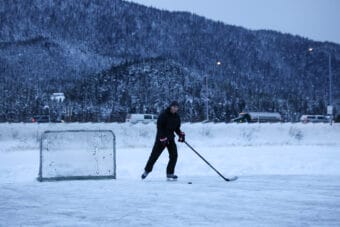
One of the forgotten dangers of living in Alaska is a roof full of snow. It might make for a cozy cabin photo, but the chance of a roof collapse — or being caught in an avalanche of roof snow — is real.
Haines is reporting nearly four feet of snow at multiple locations. And with high winds expected throughout the week, drifting snow can cause greater depths.
Erik Stevens from the Haines Avalanche Center says addressing your snowy roof while it’s cold can prevent problems later on when it warms up.
“I definitely recommend people be cautious. But it’s also a good idea to get that snow off your roof,” he said. “If it’s piling up, then it’s not shedding naturally. I’d hate for the next storm to come in real heavy and wet it could double the load pretty easily.”
Stevens says the Haines Avalanche Center measured the ground snow load over the weekend and found the snow weighs 57 pounds per square foot.
“I’ve heard of yurts collapsing pretty frequently here in Haines. I’ve seen garages and boat sheds collapse pretty frequently. I don’t think I’ve heard so much about residential homes collapsing. But every now and then, there’s a flat-roofed business that might collapse,” he said.
In Skagway, fire department officials warn that heat from inside the house can cause the snow closest to the roof to melt, which can later freeze. That can be a problem for firefighters when there’s a chimney fire.
Firefighter Engineer Zak Overmyer says they don’t wear cleats on their boots to get a good grip on icy roofs because that’s dangerous when climbing ladders. He also says that time spent shoveling snow instead of fighting the fire can lead to more damage, and heavy snow loads can cause collapses.
“If the house itself does get involved in a fire, having that extra load on the roof and extra weight will make those trusses and ceilings and stuff fail a lot quicker,” Overmyer said.
Another potential danger from excessive snow on roofs is a roof-snow avalanche. Last January, a Haines man was buried while collecting firewood out by Mosquito Lake. As the Chilkat Valley News reported, a former heli-ski guide was grabbing a couple of logs for his wood stove at night when the roof-snow gave way and buried him.
He managed to use his cell phone to alert neighbors, who helped rescue him after about 45 minutes.
But Stevens says shoveling a roof can also cause a slide — slides can happen anytime if the roof has a steep pitch.
“Metal roofs are particularly slick underneath. And they tend to slide when it warms up. When it’s cold they’re not likely to slide, but they could,” he said. “If your roof is around 30 degrees or steeper, I do not recommend getting on top of it or under it at all, because it could shed really at any time.”
He says snow drifts piling up on one section of the roof can also create problems and suggests having a structural engineer inspect your roof if you are unsure if it can handle the winter’s snow load.
In addition to the nearly four feet of snow in Haines, Dyea is reporting two feet and the William Moore Bridge on the Klondike Highway is reporting three feet. In town, Skagway is reporting 16 inches.
Skagway officials suggest hiring a local contractor to help with snow removal if necessary.



